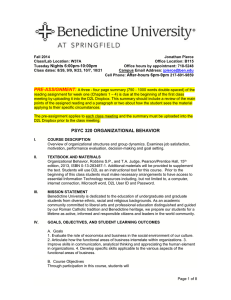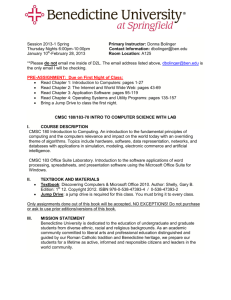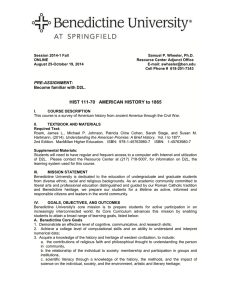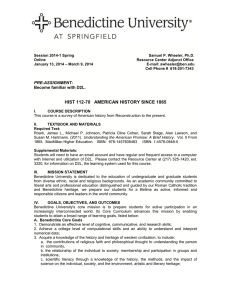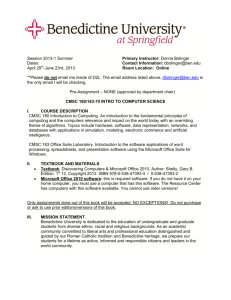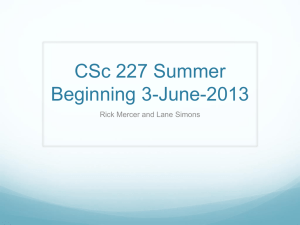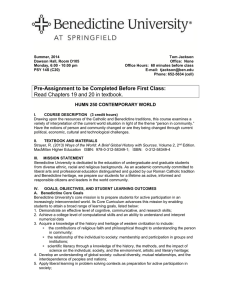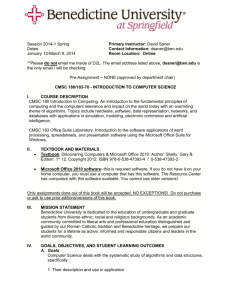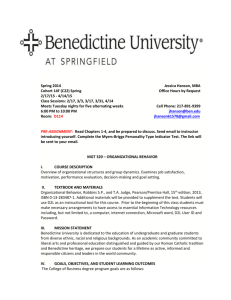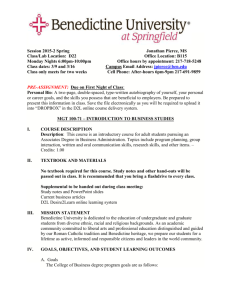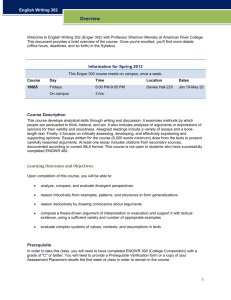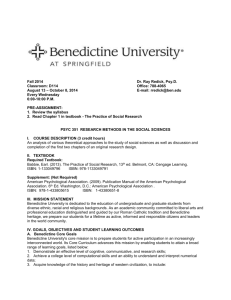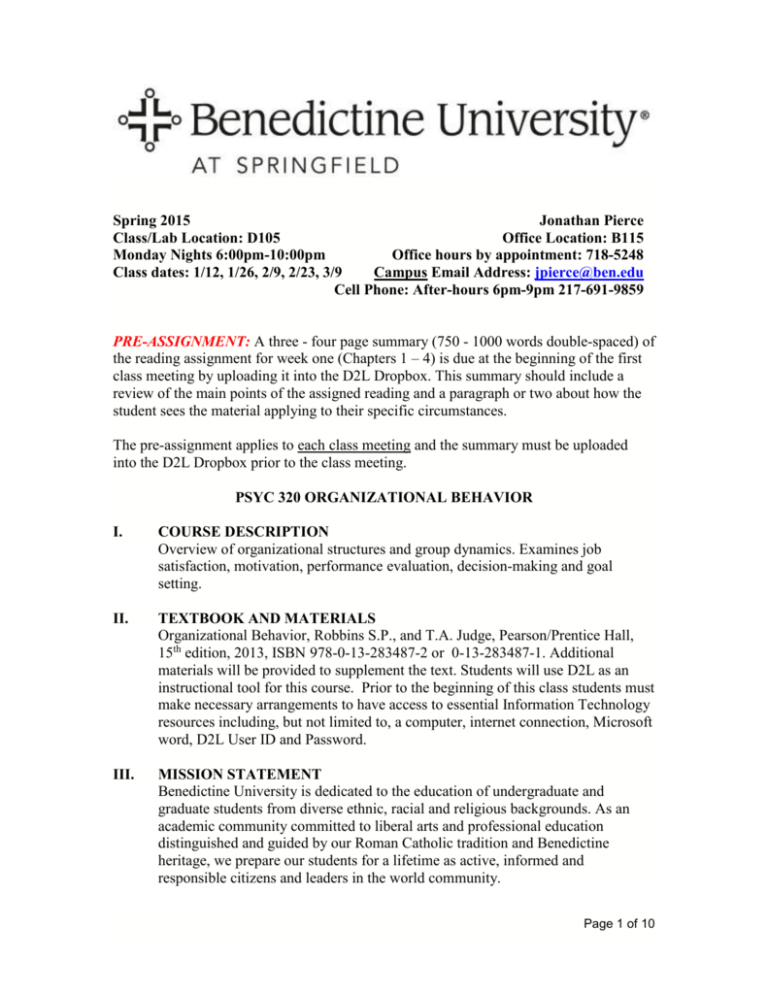
Spring 2015
Jonathan Pierce
Class/Lab Location: D105
Office Location: B115
Monday Nights 6:00pm-10:00pm
Office hours by appointment: 718-5248
Class dates: 1/12, 1/26, 2/9, 2/23, 3/9
Campus Email Address: jpierce@ben.edu
Cell Phone: After-hours 6pm-9pm 217-691-9859
PRE-ASSIGNMENT: A three - four page summary (750 - 1000 words double-spaced) of
the reading assignment for week one (Chapters 1 – 4) is due at the beginning of the first
class meeting by uploading it into the D2L Dropbox. This summary should include a
review of the main points of the assigned reading and a paragraph or two about how the
student sees the material applying to their specific circumstances.
The pre-assignment applies to each class meeting and the summary must be uploaded
into the D2L Dropbox prior to the class meeting.
PSYC 320 ORGANIZATIONAL BEHAVIOR
I.
COURSE DESCRIPTION
Overview of organizational structures and group dynamics. Examines job
satisfaction, motivation, performance evaluation, decision-making and goal
setting.
II.
TEXTBOOK AND MATERIALS
Organizational Behavior, Robbins S.P., and T.A. Judge, Pearson/Prentice Hall,
15th edition, 2013, ISBN 978-0-13-283487-2 or 0-13-283487-1. Additional
materials will be provided to supplement the text. Students will use D2L as an
instructional tool for this course. Prior to the beginning of this class students must
make necessary arrangements to have access to essential Information Technology
resources including, but not limited to, a computer, internet connection, Microsoft
word, D2L User ID and Password.
III.
MISSION STATEMENT
Benedictine University is dedicated to the education of undergraduate and
graduate students from diverse ethnic, racial and religious backgrounds. As an
academic community committed to liberal arts and professional education
distinguished and guided by our Roman Catholic tradition and Benedictine
heritage, we prepare our students for a lifetime as active, informed and
responsible citizens and leaders in the world community.
Page 1 of 10
IV.
GOALS, OBJECTIVES, AND STUDENT LEARNING OUTCOMES
A. Goals
1. Evaluate the role of economics and business in the social environment of our
culture. 2. Articulate how the functional areas of business interrelate within
organizations. 3. Improve skills in communication, analytical thinking and
appreciating the human element in organizations. 4. Develop specific skills
applicable to the various aspects of the functional areas of business.
B. Course Objectives
Through participation in this course, students will
Demonstrate an understanding of the roles and functions of
Organizational Behavior as a field of study and practice
Place Organizational Behavior within the context of the science and
practice of Management
Discuss the application of Organizational Behavior principles and
techniques to firms and governmental agencies, and democratic
institutions
Identify the role of diversity in Organizational Behavior
Discuss the application of Organizational Behavior principles and
practices to individuals careers
Describe how individual professionals apply the principles and
practices of Organizational Behavior to their specific professions.
V.
TEACHING METHODS/DELIVERY SYSTEM
The course will include lecture sessions, class discussion, audio-visual
presentations, participatory student activities, and information distributed via
D2L. This class is very interactive. In order to complete the course successfully,
students must come to class and must be prepared to discuss the reading
assignments and to do the in-class work.
VI.
COURSE REQUIREMENTS
Attendance Policy
This course is highly accelerated, and students will need to take a great deal of
responsibility for their own learning outcomes. Attendance is required in each
class meeting for the full period of time. Any absence must be due to
extraordinary circumstances and will require documentation for it to be
considered excused. Documentation must be provided immediately in order to
determine what, if any, accommodations are reasonable or possible. Class
attendance will directly impact your final grade, and each undocumented absence
will be considered unexcused and will result in a 20% reduction in the final grade
for the course.
Page 2 of 10
Due to the accelerated nature of the course, should you experience a medical
condition which prevents you from attending any class(es), appropriate medical
documentation must be provided immediately so it may be determined what, if
any, accommodations are reasonable or possible.
Reading Assignments
Week 1 Text Chapters 1-4
Week 2 Text Chapters 5-8
Week 3 Text Chapters 9-12
Week 4 Text Chapters 13-16
Week 5 Text Chapters 17-18
Written Assignments and Projects
A) A three - four page summary (750 - 1000 words double-spaced) of the reading
assignment for each week (including the first class) is due before each class
meeting. This summary should include a review of the main points of the
assigned reading and a paragraph or two about how the student sees the
material applying to their specific circumstances. These assignments are to be
posted in the D2L Dropbox for the course. These papers are to be written in
paragraph form (not bulleted); in your own words describing what you read;
using proper English, grammar, and punctuation.
B) A five to seven page final paper is required which is to be on a topic chosen
by the student from among the topics covered in course material. The paper is
to be prepared using APA style. References for the final paper must include
at least three sources outside the material used during class. The APA style of
writing dictates that it must be written in Times New Roman font size 12,
double-spaced, with 1 inch margins on all sides, and must include a cover
page and a reference page. The cover page and reference page do not count as
part of your five to seven page requirement. The APA style further requires
the use of headings. This paper is due by 11:59pm on one week after the final
class meeting.
For further information about the APA style of writing, please go to this
website: http://apastyle.org
Post - Class Assignments
Each class will include a post-class assignment that will be posted on D2L for
which specific instructions will be included on that posting.
Class Participation
Students will be evaluated on the basis of participation in discussions. Points
for participation will only be awarded if students are present.
Page 3 of 10
Benedictine University at Springfield Student Academic Honesty Policy
The search for truth and the dissemination of knowledge are the central
missions of a university. Benedictine University at Springfield pursues these
missions in an environment guided by our Roman Catholic tradition and our
Benedictine heritage. Integrity and honesty are therefore expected of all
University students. Actions such as cheating, plagiarism, collusion,
fabrication, forgery, falsification, destruction, multiple submission,
solicitation, and misrepresentation are violations of these expectations and
constitute unacceptable behavior in the University community.
Student’s Responsibility
Though there is no formal honor code at Benedictine University at
Springfield, students are expected to exhibit academic honesty at all times.
Violations against academic honesty are always serious and may result in
sanctions that could have profound long-term effects. The final responsibility
for understanding the Academic Honesty Policy of the institution, as well as
the specific policies for individual courses normally found in syllabi, rests
with students. If any doubt exists about what constitutes academic dishonesty,
students have the responsibility to talk to the faculty member. Students
should expect the members of their class to be academically honest. If
students believe one or more members of the class have been deceitful to gain
academic advantage in the class, students should feel comfortable to approach
the faculty member of the course without prejudice.
Violations of the Academic Honesty Policy will be reported to the Office of
the Dean of Academic Affairs. Along with a verbal warning, the following
are consequences a student may face for academic dishonesty:
a failing grade or “zero” for the assignment;
dismissal from and a failing grade for the course; or
dismissal from the Institution.
VII.
MEANS OF EVALUATION
100 points each for 750 word textbook reading assignment summaries for a
total of 500 points
25 points per week for participation in class discussion for a total of 125
points
25 points per week for completion of post-class assignments for a total of
125 points
250 points for Final Paper to be delivered in the D2L Dropbox no later than
one week following the last class meeting.
Total available points for class 1000
Page 4 of 10
A = 1000 - 900 Points (90% - 100%)
B = 899 - 800 Points (80% - 89%)
C = 799 - 700 Points (70% - 79%)
D = 699 - 600 Points (60 – 69%)
F = <600 Points (<60%)
Assignments that are turned in late will receive a 10% reduction in grade for
every day they are late. No projects or assignments will be accepted more
than one week past the due date. Projects or assignments turned in more
than one week late will receive zero (0) points.
A Grading Rubric for papers and class discussion will be distributed at the first
class and will be posted on D2L.
If a student believes that an error has been made in reporting a grade, an appeal
must be made in writing to the instructor and must be initiated within 60 calendar
days after the end of the term for which the grade in question was reported. The
appeal should contain specific information about why it is believed the grade
reported is inaccurate. See the Student Handbook for additional details.
Add/Drop Dates
Please refer to the current Academic Calendar for add/drop dates.
Incomplete Request
To qualify for an “I” grade, a minimum of 75% of the course work must be
completed with a “C” or better, and a student must submit a completed “Request
for an Incomplete” form to the Registrar’s Office. The form must be completed
by both student and instructor, but it is the student’s responsibility (not the
instructor’s) to initiate this process and obtain the necessary signatures.
Student Withdrawal Procedure
It is the student’s responsibility to officially withdraw from a course by
completing the appropriate form, with appropriate signatures, and returning the
completed form to the Advising Office. Please refer to the Student Handbook for
important financial information related to withdrawals.
VIII. TOPICAL COURSE OUTLINE
Chapter 1: What is Organizational Behavior
LEARNING OBJECTIVES
Demonstrate the importance of interpersonal skills in the workplace.
Describe the manager’s functions, roles, and skills.
Define organizational behavior (OB).
Show the value to OB of systematic study.
Identify the major behavioral science disciplines that contribute to OB.
Demonstrate why there are few absolutes in OB.
Page 5 of 10
Identify the challenges and opportunities managers have in applying OB concepts.
Compare the three levels of analysis in this book’s OB model.
Chapter 2: Diversity in Organizations
LEARNING OBJECTIVES
Describe the two major forms of workforce diversity.
Recognize stereotypes and understand how they function in organizational
settings.
Identify the key biographical characteristics and describe how they are relevant to
OB.
Define intellectual ability and demonstrate its relevance to OB.
Contrast the two types of ability.
Describe how organizations manage diversity effectively.
Chapter 3: Attitudes and Job Satisfaction
LEARNING OBJECTIVES
Contrast the three components of an attitude.
Summarize the relationship between attitudes and behavior.
Compare and contrast the major job attitudes.
Define job satisfaction and show how it can be measured.
Summarize the main causes of job satisfaction.
Identify four employee responses to dissatisfaction.
Chapter 4: Emotions and Moods
LEARNING OBJECTIVES
Differentiate emotions from moods and list the basic emotions and moods.
Discuss whether emotions are rational and what functions they serve.
Identify the sources of emotions and moods.
Show the impact emotional labor has on employees.
Describe affective events theory and identify its applications.
Contrast the evidence for and against the existence of emotional intelligence.
Identify strategies for emotion regulation and their likely effects.
Apply concepts about emotions and moods to specific OB issues.
Chapter 5: Personality and Values
LEARNING OBJECTIVES
Define personality, describe how it is measured, and explain the factors that
determine an individual’s personality.
Describe the Myers-Briggs Type Indicator personality framework and assess its
strengths and weaknesses.
Identify the key traits in the Big Five personality model.
Demonstrate how the Big Five traits predict behavior at work.
Identify other personality traits relevant to OB.
Define values, demonstrate the importance of values, and contrast terminal and
instrumental values.
Page 6 of 10
Compare generational differences in values and identify the dominant values in
today’s workforce.
Identify Hofstede’s five value dimensions of national culture.
Chapter 6: Perception and Individual Decision Making
LEARNING OBJECTIVES
Define perception and explain the factors that influence it.
Explain attribution theory and list the three determinants of attribution.
Identify the shortcuts individuals use in making judgments about others.
Explain the link between perception and decision making.
Apply the rational model of decision making and contrast it with bounded
rationality and intuition.
List and explain the common decision biases or errors.
Explain how individual differences and organizational constraints affect decision
making.
Contrast the three ethical decision criteria.
Define creativity and discuss the three-component models of creativity.
Chapter 7: Motivation concepts
LEARNING OBJECTIVES
Describe the three key elements of motivation.
Identify early theories of motivation and evaluate their applicability today.
Apply the predictions of self-determination theory to intrinsic and extrinsic
rewards.
Understand the implications of employee engagement for management.
Compare and contrast goal-setting theory and management by objectives.
Contrast reinforcement theory and goal-setting theory.
Demonstrate how organizational justice is a refinement of equity theory.
Apply the key tenets of expectancy theory to motivating employees.
Compare contemporary theories of motivation.
Chapter 8: Motivation: From Concepts to Application
LEARNING OBJECTIVES
Describe the job characteristics model and evaluate the way it motivates by
changing the work environment.
Compare and contrast the three main ways jobs can be redesigned.
Identify three alternative work arrangements and show how they might motivate
employees.
Give examples of employee involvement measures and show how they can
motivate employees.
Demonstrate how the different types of variable-pay programs can increase
employee motivation.
Show how flexible benefits turn benefits into motivators.
Identify the motivational benefits of intrinsic rewards.
Chapter 9: Foundations of Group Behavior
Page 7 of 10
LEARNING OBJECTIVES
Define group and differentiate between different types of groups.
Identify the five stages of group development.
Show how role requirements change in different situations.
Demonstrate how norms and status exert influence on an individual’s behavior.
Show how group size affects group performance.
Contrast the benefits and disadvantages of cohesive groups.
Understand the implications of diversity for group effectiveness.
Contrast the strengths and weaknesses of group decision making.
Compare the effectiveness of interacting, brainstorming, nominal, and electronic
meeting groups.
Chapter 10: Understanding Work Teams
LEARNING OBJECTIVES
Analyze the growing popularity of using teams in organizations.
Contrast groups and teams.
Compare and contrast four types of teams.
Identify the characteristics of effective teams.
Show how organizations can create team players.
Decide when to use individuals instead of teams.
Show how the understanding of teams differs in a global context.
Chapter 11: Communication
LEARNING OBJECTIVES
Identify the main functions of communication.
Describe the communication process and distinguish between formal and
informal communication.
Contrast downward, upward, and lateral communication, and provide examples of
each.
Contrast oral, written, and nonverbal communication.
Analyze the advantages and challenges of electronic communication.
Show how channel richness underlies the choice of communication channel.
Differentiate between automatic and controlled processing of persuasive
messages.
Identify common barriers to effective communication.
Show how to overcome the potential problems in cross-cultural communication.
Chapter 12: Leadership
LEARNING OBJECTIVES
Define leadership and contrast leadership and management.
Summarize the conclusions of trait theories of leadership.
Identify the central tenets and main limitations of behavioral theories.
Assess contingency theories of leadership by their level of support.
Compare and contrast charismatic and transformational leadership.
Define authentic leadership and show why effective leaders exemplify ethics and
trust.
Page 8 of 10
Demonstrate the role mentoring plays in our understanding of leadership.
Address challenges to the effectiveness of leadership.
Chapter 13: Power and Politics
LEARNING OBJECTIVES
Define power and contrast leadership and power.
Contrast the five bases of power.
Explain the role of dependence in power relationships.
Identify nine power or influence tactics and their contingencies.
Show the connection between sexual harassment and the abuse of power.
Identify the causes and consequences of political behavior.
Apply impression management techniques.
Determine whether a political action is ethical.
Chapter 14: Conflict and Negotiations
LEARNING OBJECTIVES
Define conflict.
Differentiate between the traditional, interactionist, and managed-conflict views
of conflict.
Outline the conflict process.
Define negotiation.
Contrast distributive and integrative bargaining.
Apply the five steps of the negotiation process.
Show how individual differences influence negotiations.
Assess the roles and functions of third-party negotiations.
Chapter 15: Foundations of Organization Structure
LEARNING OBJECTIVES
Identify the six elements of an organization’s structure.
Identify the characteristics of a bureaucracy.
Describe a matrix organization.
Identify the characteristics of a virtual organization.
Show why managers want to create boundaryless organizations.
Demonstrate how organizational structures differ and contrast mechanistic and
organic structural models.
Analyze the behavioral implications of different organizational designs.
Chapter 16: Organizational Culture
LEARNING OBJECTIVES
Define organizational culture and describe its common characteristics.
Compare the functional and dysfunctional effects of organizational culture on
people and the organization.
Identify the factors that create and sustain an organization’s culture.
Show how culture is transmitted to employees.
Demonstrate how an ethical culture can be created.
Describe a positive organizational culture.
Page 9 of 10
Identify characteristics of a spiritual culture.
Show how national culture may affect the way organizational culture is
transported to a different country.
Chapter 17: Human Resources Policies and Practices
LEARNING OBJECTIVES
Define initial selection, and identify the most useful methods.
Define substantive selection, and identify the most useful methods.
Define contingent selection, and contrast the arguments for and against drug
testing.
Compare the four main types of training.
Contrast formal and informal training methods
Contrast on-the-job and off-the-job training.
Describe the purposes of performance evaluation and list the methods by which it
can be done.
Show how managers can improve performance evaluations.
Describe how organizations can manage work-family conflicts.
Chapter 18: Organizational Change and Stress Management
LEARNING OBJECTIVES
Identify forces that act as stimulants to change and contrast planned and
unplanned change.
List the forces for resistance to change.
Compare the four main approaches to managing organizational change.
Demonstrate two ways of creating a culture for change.
Define stress and identify its potential sources.
Identify the consequences of stress.
Contrast the individual and organizational approaches to managing stress.
IX.
AMERICANS WITH DISABILITIES ACT (ADA)
Benedictine University at Springfield provides individuals with disabilities
reasonable accommodations to participate in educational programs, activities, and
services. Students with disabilities requiring accommodations to participate in
campus-sponsored programs, activities, and services, or to meet course
requirements, should contact the Resource Center as early as possible:
springaccess@ben.edu or (217) 717-9253.
X.
ASSESSMENT
Goals, objectives, and learning outcomes that will be assessed in the class are
stated in this syllabus. Instructor will use background knowledge probes, oneminute papers, reflective essays and/or other Classroom Assessment Techniques
as deemed necessary in order to provide continuous improvement of instruction.
JR 12/15/14
Page 10 of 10

